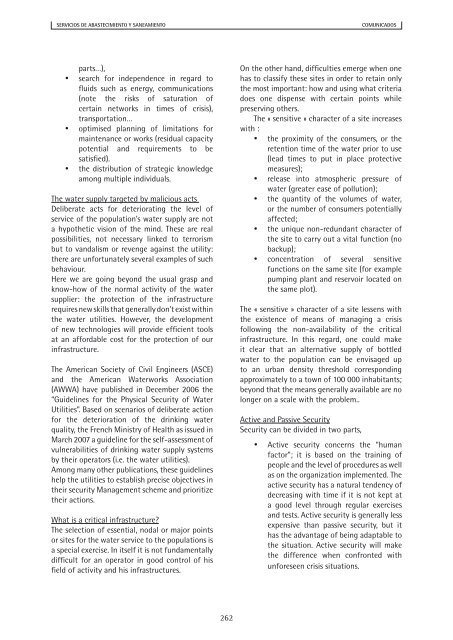Servicios de Abastecimiento y Saneamiento - La Tribuna del Agua
Servicios de Abastecimiento y Saneamiento - La Tribuna del Agua
Servicios de Abastecimiento y Saneamiento - La Tribuna del Agua
You also want an ePaper? Increase the reach of your titles
YUMPU automatically turns print PDFs into web optimized ePapers that Google loves.
SERVICIOS DE ABASTECIMIENTO Y SANEAMIENTO<br />
•<br />
•<br />
•<br />
parts…),<br />
search for in<strong>de</strong>pen<strong>de</strong>nce in regard to<br />
fluids such as energy, communications<br />
(note the risks of saturation of<br />
certain networks in times of crisis),<br />
transportation…<br />
optimised planning of limitations for<br />
maintenance or works (residual capacity<br />
potential and requirements to be<br />
satisfied).<br />
the distribution of strategic knowledge<br />
among multiple individuals.<br />
The water supply targeted by malicious acts<br />
Deliberate acts for <strong>de</strong>teriorating the level of<br />
service of the population’s water supply are not<br />
a hypothetic vision of the mind. These are real<br />
possibilities, not necessary linked to terrorism<br />
but to vandalism or revenge against the utility:<br />
there are unfortunately several examples of such<br />
behaviour.<br />
Here we are going beyond the usual grasp and<br />
know-how of the normal activity of the water<br />
supplier: the protection of the infrastructure<br />
requires new skills that generally don’t exist within<br />
the water utilities. However, the <strong>de</strong>velopment<br />
of new technologies will provi<strong>de</strong> efficient tools<br />
at an affordable cost for the protection of our<br />
infrastructure.<br />
The American Society of Civil Engineers (ASCE)<br />
and the American Waterworks Association<br />
(AWWA) have published in December 2006 the<br />
“Gui<strong>de</strong>lines for the Physical Security of Water<br />
Utilities”. Based on scenarios of <strong>de</strong>liberate action<br />
for the <strong>de</strong>terioration of the drinking water<br />
quality, the French Ministry of Health as issued in<br />
March 2007 a gui<strong>de</strong>line for the self-assessment of<br />
vulnerabilities of drinking water supply systems<br />
by their operators (i.e. the water utilities).<br />
Among many other publications, these gui<strong>de</strong>lines<br />
help the utilities to establish precise objectives in<br />
their security Management scheme and prioritize<br />
their actions.<br />
What is a critical infrastructure?<br />
The selection of essential, nodal or major points<br />
or sites for the water service to the populations is<br />
a special exercise. In itself it is not fundamentally<br />
difficult for an operator in good control of his<br />
field of activity and his infrastructures.<br />
262<br />
COMUNICADOS<br />
On the other hand, difficulties emerge when one<br />
has to classify these sites in or<strong>de</strong>r to retain only<br />
the most important: how and using what criteria<br />
does one dispense with certain points while<br />
preserving others.<br />
The « sensitive » character of a site increases<br />
with :<br />
•<br />
•<br />
•<br />
•<br />
•<br />
the proximity of the consumers, or the<br />
retention time of the water prior to use<br />
(lead times to put in place protective<br />
measures);<br />
release into atmospheric pressure of<br />
water (greater ease of pollution);<br />
the quantity of the volumes of water,<br />
or the number of consumers potentially<br />
affected;<br />
the unique non-redundant character of<br />
the site to carry out a vital function (no<br />
backup);<br />
concentration of several sensitive<br />
functions on the same site (for example<br />
pumping plant and reservoir located on<br />
the same plot).<br />
The « sensitive » character of a site lessens with<br />
the existence of means of managing a crisis<br />
following the non-availability of the critical<br />
infrastructure. In this regard, one could make<br />
it clear that an alternative supply of bottled<br />
water to the population can be envisaged up<br />
to an urban <strong>de</strong>nsity threshold corresponding<br />
approximately to a town of 100 000 inhabitants;<br />
beyond that the means generally available are no<br />
longer on a scale with the problem..<br />
Active and Passive Security<br />
Security can be divi<strong>de</strong>d in two parts,<br />
•<br />
Active security concerns the “human<br />
factor”; it is based on the training of<br />
people and the level of procedures as well<br />
as on the organization implemented. The<br />
active security has a natural ten<strong>de</strong>ncy of<br />
<strong>de</strong>creasing with time if it is not kept at<br />
a good level through regular exercises<br />
and tests. Active security is generally less<br />
expensive than passive security, but it<br />
has the advantage of being adaptable to<br />
the situation. Active security will make<br />
the difference when confronted with<br />
unforeseen crisis situations.


